SHOOT THOSE OLD RIMFIRES AGAIN!
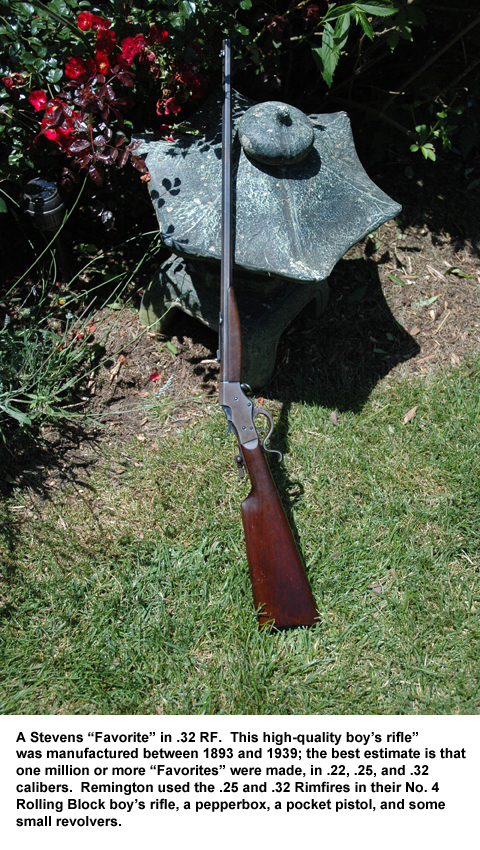
The oldest self-contained cartridge still in production—in continuous production since 1857, when S&W chambered it in their #1 revolver—is the rimfire .22 Short. Rimfire ignition, as a developmental stage in the evolution of fixed ammunition, was a logical technical progression from metal-cased ammunition ignited by an external percussion cap (such as the Maynard and Sharps rounds). Rimfire cartridges are a true self-contained type: all the components are contained in one compact, weatherproof, and reliable package.
Before the United States entered World War Two, rimfire cartridges were made in several calibers that had become popular in the previous century. In the significant year of 1939 the Stoeger Arms catalog listed rimfire ammunition in .22, .25, .32, .38, and .41 calibers. There was a real market for these: many late 19th and early 20th Century small game rifles were chambered for .22, .25, and .32 Rimfire by, among other makers, Stevens, Remington, and Savage. In the 19th Century Remington used the .32 RF in a pepperbox, a pocket pistol, and some of their small revolvers. The famous Remington Double Derringer was chambered exclusively for the .41 Rimfire. Colt used the .41 Rimfire in its Third Model derringer and New Line revolver. In 1939, substantial numbers of these and many other guns using large caliber rimfire ammunition were still in widespread use.
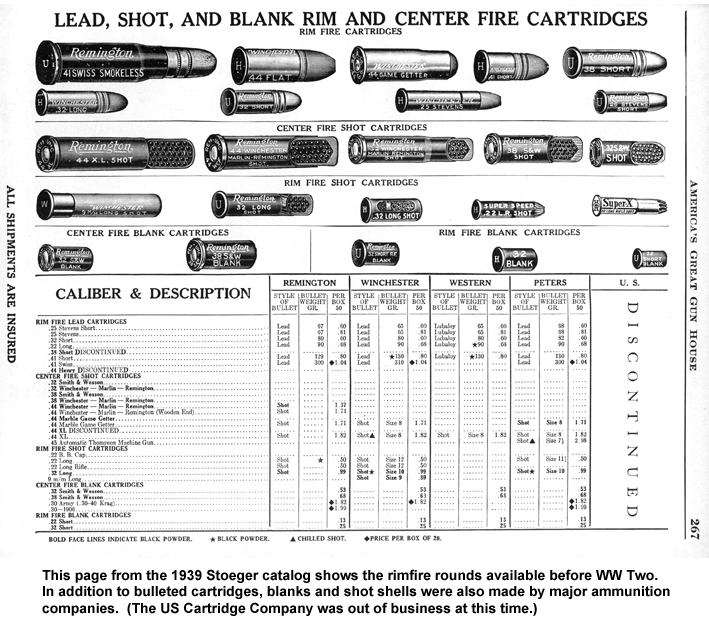 Today all rimfire calibers larger than .22 have vanished. By 1946 almost all of the guns that fired them
had been discontinued. Moreover, the
transition to smokeless powder and non-corrosive priming in the post-World War
One period had vastly improved the .22 Long Rifle’s performance. The older guns had of course been designed for use
with black powder: by 1946 a lot of them
were worn to the point where using smokeless powder might have been
unsafe. The period immediately following
World War Two saw a wholesale re-evaluation of the market by all the major
ammunition makers, and many calibers were eliminated from their product lines,
including virtually all the rimfire rounds larger than .22 caliber. Owners of
the old guns would have to make do with existing stocks of ammunition, and when
those ran out…well, they’d have to buy new guns, wouldn’t they?
Today all rimfire calibers larger than .22 have vanished. By 1946 almost all of the guns that fired them
had been discontinued. Moreover, the
transition to smokeless powder and non-corrosive priming in the post-World War
One period had vastly improved the .22 Long Rifle’s performance. The older guns had of course been designed for use
with black powder: by 1946 a lot of them
were worn to the point where using smokeless powder might have been
unsafe. The period immediately following
World War Two saw a wholesale re-evaluation of the market by all the major
ammunition makers, and many calibers were eliminated from their product lines,
including virtually all the rimfire rounds larger than .22 caliber. Owners of
the old guns would have to make do with existing stocks of ammunition, and when
those ran out…well, they’d have to buy new guns, wouldn’t they?
While discontinuing the large caliber rimfires was economically a sound decision it had consequences, especially for small game hunters. The .25 and especially the .32 Rimfire were accurate, quiet, and entirely suited to hunting. Both were about as perfect small-game calibers as could be imagined. The rifles chambered for them were generally of very high quality, showing levels of craftsmanship that couldn’t be duplicated at reasonable prices today. Many are still in shooting condition, but today they languish in closets for want of something to put in them. The immensely popular Stevens “Favorite” and Remington No. 4 rifles routinely show up on auction sites at attractive prices, but ammunition for them—especially in the .25 caliber—is scarcer than frog hair. Another caliber no longer made is the .41 Swiss military round. Around the turn of the 20th Century hundreds of thousands of beautiful old Vetterli rifles firing it were sold in the USA, but the ammunition was dropped along with the other rimfires in 1946. The Vetterli is suited to hunting deer and other medium sized game, and so many of these guns are coming out of closets that it’s a shame there’s no way to put them back into the field.
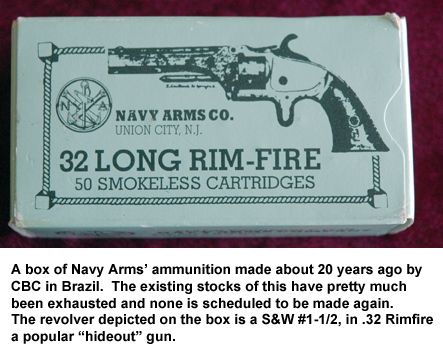 Recognizing that a small (and diminishing) market still
existed, about 20 years ago the CBC plant in Brazil made a run of .32 Long and
.41 Short Rimfire (for the Remington Derringer) which was sold through Navy
Arms. But production ended and no more seems
to be forthcoming, despite repeated requests to Navy Arms to bring back at
least some of the old calibers. Prices
for this “new” ammunition are steadily climbing as the supply dries up
completely. Five years ago if you could
find a box of the Navy Arms/CBC .32 RF ammunition it would set you back $40-50;
today it appears to have vanished from the market almost completely, and what little is still out there goes for
three to five times that. Some very,
very old copper-cased ammunition is found on collectors’ sites, at prices that
are hard to believe. Even if they will
go off (a lot of this stuff is more than a century old and it won’t) at
anywhere from $5 to $15 per round, sometimes more, it’s far too expensive to
shoot.
Recognizing that a small (and diminishing) market still
existed, about 20 years ago the CBC plant in Brazil made a run of .32 Long and
.41 Short Rimfire (for the Remington Derringer) which was sold through Navy
Arms. But production ended and no more seems
to be forthcoming, despite repeated requests to Navy Arms to bring back at
least some of the old calibers. Prices
for this “new” ammunition are steadily climbing as the supply dries up
completely. Five years ago if you could
find a box of the Navy Arms/CBC .32 RF ammunition it would set you back $40-50;
today it appears to have vanished from the market almost completely, and what little is still out there goes for
three to five times that. Some very,
very old copper-cased ammunition is found on collectors’ sites, at prices that
are hard to believe. Even if they will
go off (a lot of this stuff is more than a century old and it won’t) at
anywhere from $5 to $15 per round, sometimes more, it’s far too expensive to
shoot.
Of course it’s possible to modify a rimfire rifle to shoot centerfire ammunition, but there are reasons not to do that. First, it requires skilled gunsmithing; second, it vastly reduces the collector value. And third, aside from the technical aspects of such a conversion, what happens when someone slips a “hot” reloaded round into a soft-iron action designed for black powder?
It’s an inexorable law of economics that when a strong demand for something exists, a supply of it eventually surfaces. The existence of so many old large-caliber rimfire guns in good condition has created exactly this situation. And at least one company has come up with a clever way to produce shootable ammunition in several old rimfire calibers relatively economically.
The H&C Company, located in the commune of Saint Genis-Laval, not far from Lyons, France, uses modern machinery to produce re-usable cartridge cases in .32, .38, and .41 Rimfire. (Unfortunately .25 RF isn’t available, probably because the case head is too small.)
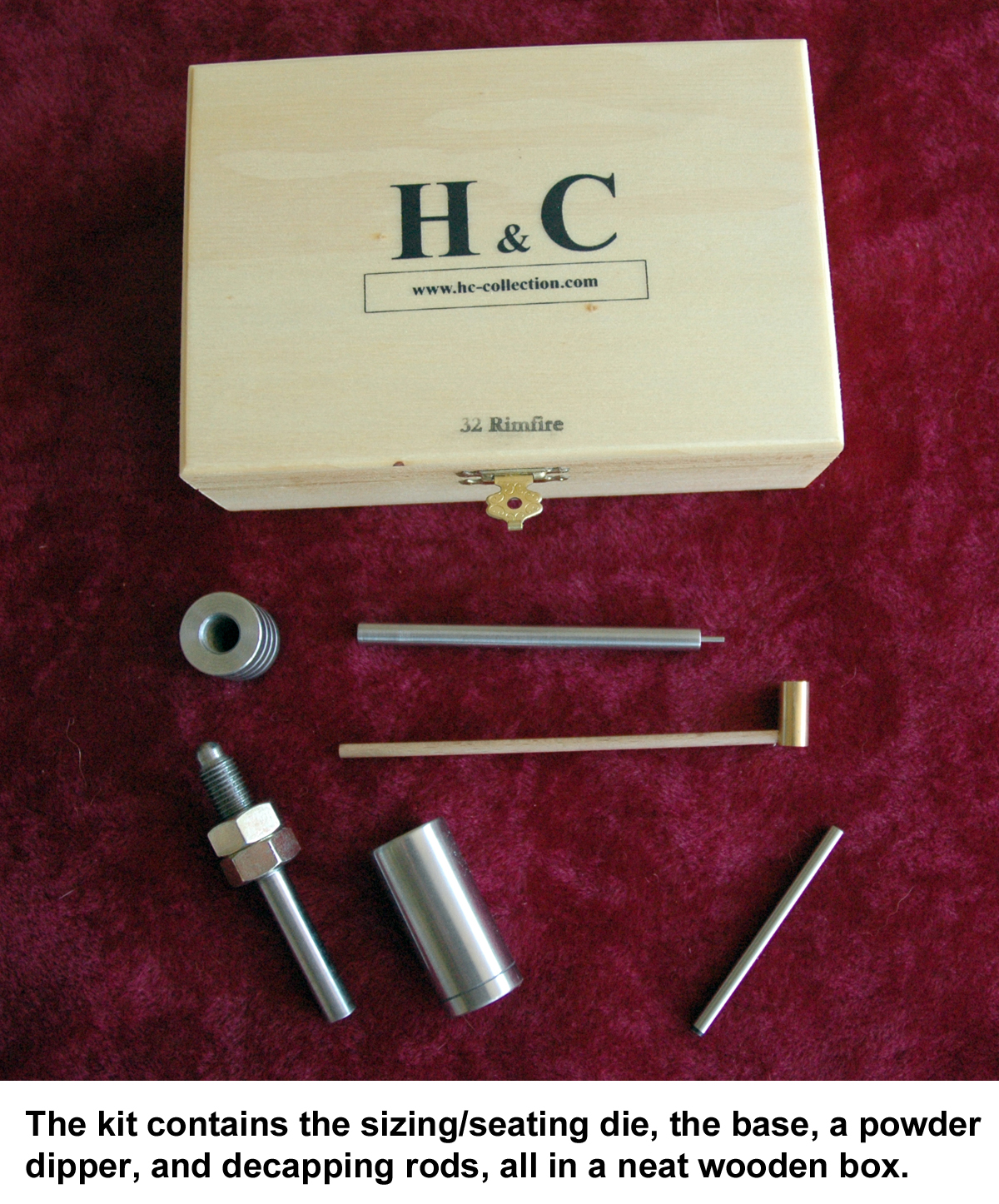
 I own a Stevens Favorite in .32 RF, so I ordered one of
their kits in that caliber. It included
a sizing/seating die, a base, a couple of decapping tools, and a small powder
dipper; also 12 cases and 100 cast bullets. More cases and bullets can be ordered separately. H&C’s cases are precision turned from
brass bar stock. They’re of what used to
be called the “Everlasting” type: the walls are very thick and the cases very
sturdy.
I own a Stevens Favorite in .32 RF, so I ordered one of
their kits in that caliber. It included
a sizing/seating die, a base, a couple of decapping tools, and a small powder
dipper; also 12 cases and 100 cast bullets. More cases and bullets can be ordered separately. H&C’s cases are precision turned from
brass bar stock. They’re of what used to
be called the “Everlasting” type: the walls are very thick and the cases very
sturdy. 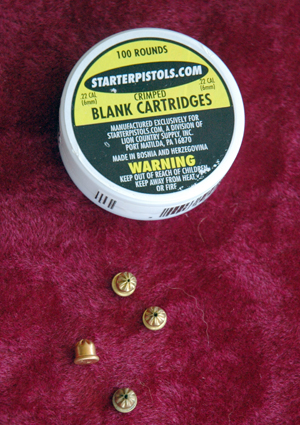 The external dimensions are
identical to those of the rimfire case but internally two main differences
exist. This first is a “step” machined
in the case mouth to accept the reduced diameter base of the bullet. The second is a notch cut in the rim, and a
“flash hole” bored through. The flash
hole is dimensioned to accept a 6mm “acorn” blank of the type used in starter
pistols, which acts as the replaceable primer. H&C also sells the special bullets
required, which are produced in a custom mold by Hensley & Gibbs. The
external bullet diameter in rimfires is the same as the case’s, hence the
bullet has a step, or “heel,” sized properly to fit the mouth of the case.
The external dimensions are
identical to those of the rimfire case but internally two main differences
exist. This first is a “step” machined
in the case mouth to accept the reduced diameter base of the bullet. The second is a notch cut in the rim, and a
“flash hole” bored through. The flash
hole is dimensioned to accept a 6mm “acorn” blank of the type used in starter
pistols, which acts as the replaceable primer. H&C also sells the special bullets
required, which are produced in a custom mold by Hensley & Gibbs. The
external bullet diameter in rimfires is the same as the case’s, hence the
bullet has a step, or “heel,” sized properly to fit the mouth of the case.
Most of the old large-caliber rimfires were externally lubricated, with a waxy coating on the bullet, such as that seen in modern .22 LR cartridges. H&C’s bullets aren’t lubricated but this is easily done by the user. They can be coated after loading with a small amount of lubricant, such as SPG, by hand. Alternatively, before loading the bullet can be coated with Lee Precision “Tumble-Lube” which dries to a waxy outer coating overnight.
The process of loading one of these cases is straightforward, although things are done “in reverse order” to the normal sequence. The first step is to insert the heel of the bullet into the case mouth using the short base of the tool as a holder. The long sizer/seater die is then placed over the round and the bullet pushed home to its shoulder using the seating stem.
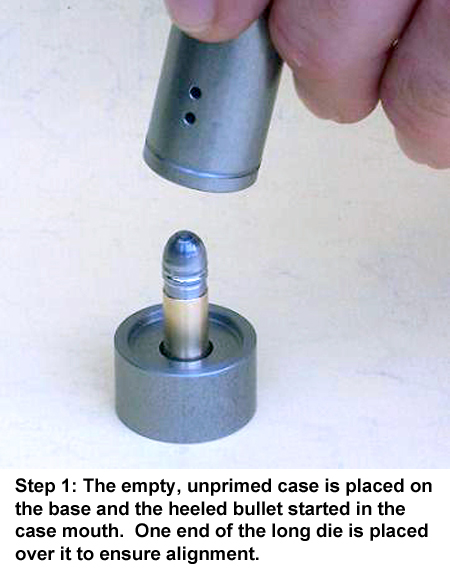
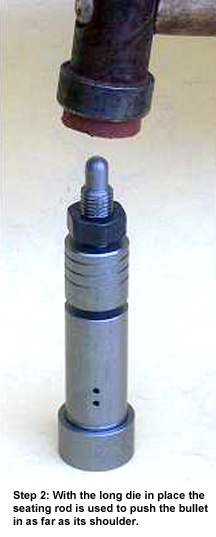
The second step is to fill the inverted case with powder. H&C is emphatic that ONLY black powder may be used safely in their cases. The acorn blank used as a primer has a lot of surface area and minimal seating friction to resist gas pressures. The little scoop provided with the kit measures almost exactly 5 grains of FFFg, an amount that leaves just enough room to insert the acorn blank.
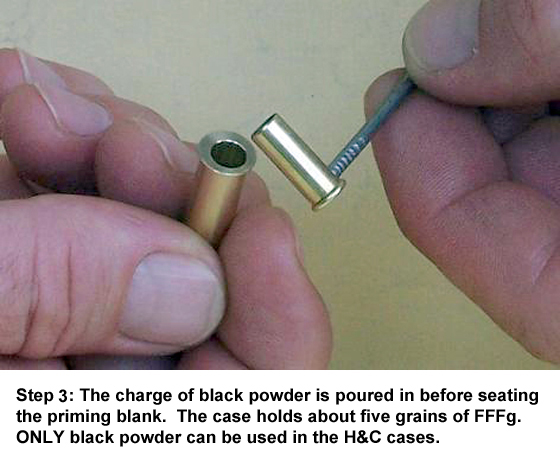
The last step is to GENTLY push the acorn blank into its recess. It’s obviously unwise to be too rough at this point! The blank will fit snugly and seats flush with the rim of the case. A plastic or leather faced tool, something sturdy but soft, is best suited to the job. I found that the brand of blanks mattered in priming and de-priming: minute dimensional differences between brands can make some of them difficult to seat or to remove, so it’s best to find one that works and stick with it.
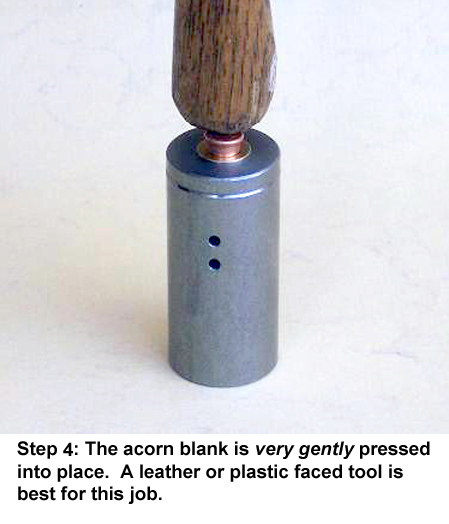
After shooting the cases must be de-primed and dropped into a container of cleaning material such as hot soapy water. After cleaning the fired cases they should be lubricated and re-sized for the next reload. This is done with the same tool used for seating the bullet: one end is machined small enough to act as a sizing die and a rod is provided to knock the sized case loose.
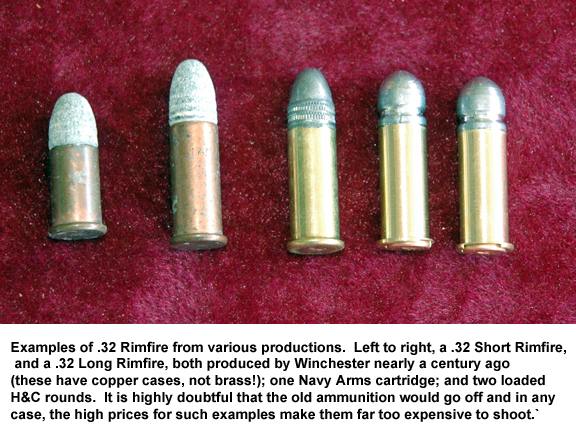
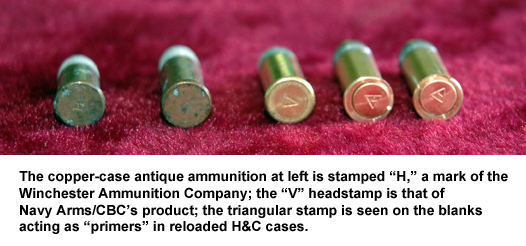
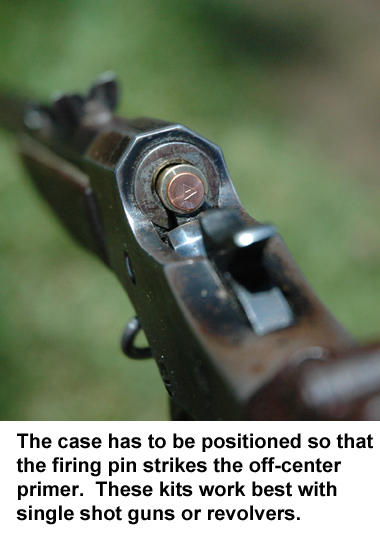 How do they shoot? Pretty well. I took my .32 RF Stevens
Model 1894 to the range and once sighted in fired several 5-shot groups at 25
yards that were well under 1-1/2”, comparable to the CBC factory ammunition.
How do they shoot? Pretty well. I took my .32 RF Stevens
Model 1894 to the range and once sighted in fired several 5-shot groups at 25
yards that were well under 1-1/2”, comparable to the CBC factory ammunition.
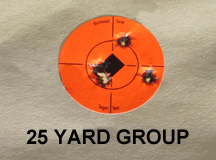 The H&C kits can be ordered on line at the company’s web
site; they accept credit cards and Paypal. In addition to the .32 Rimfire, kits are made in .38 and .41 Rimfire
Short. The kits aren’t cheap, but given
the cost of a box of sure-fire ammunition—currently well over $80 for 50 rounds
in most markets, often much more—they pay for themselves quickly. Hunting or even just plinking with an old
large-caliber rimfire is a fun and economical way to bring an old treasure out
of the closet and back into the field again. I use my little Stevens for squirrel hunting and while I have a supply
of the Navy ammunition for it, I also use the H&C product with equally good
results.
The H&C kits can be ordered on line at the company’s web
site; they accept credit cards and Paypal. In addition to the .32 Rimfire, kits are made in .38 and .41 Rimfire
Short. The kits aren’t cheap, but given
the cost of a box of sure-fire ammunition—currently well over $80 for 50 rounds
in most markets, often much more—they pay for themselves quickly. Hunting or even just plinking with an old
large-caliber rimfire is a fun and economical way to bring an old treasure out
of the closet and back into the field again. I use my little Stevens for squirrel hunting and while I have a supply
of the Navy ammunition for it, I also use the H&C product with equally good
results.
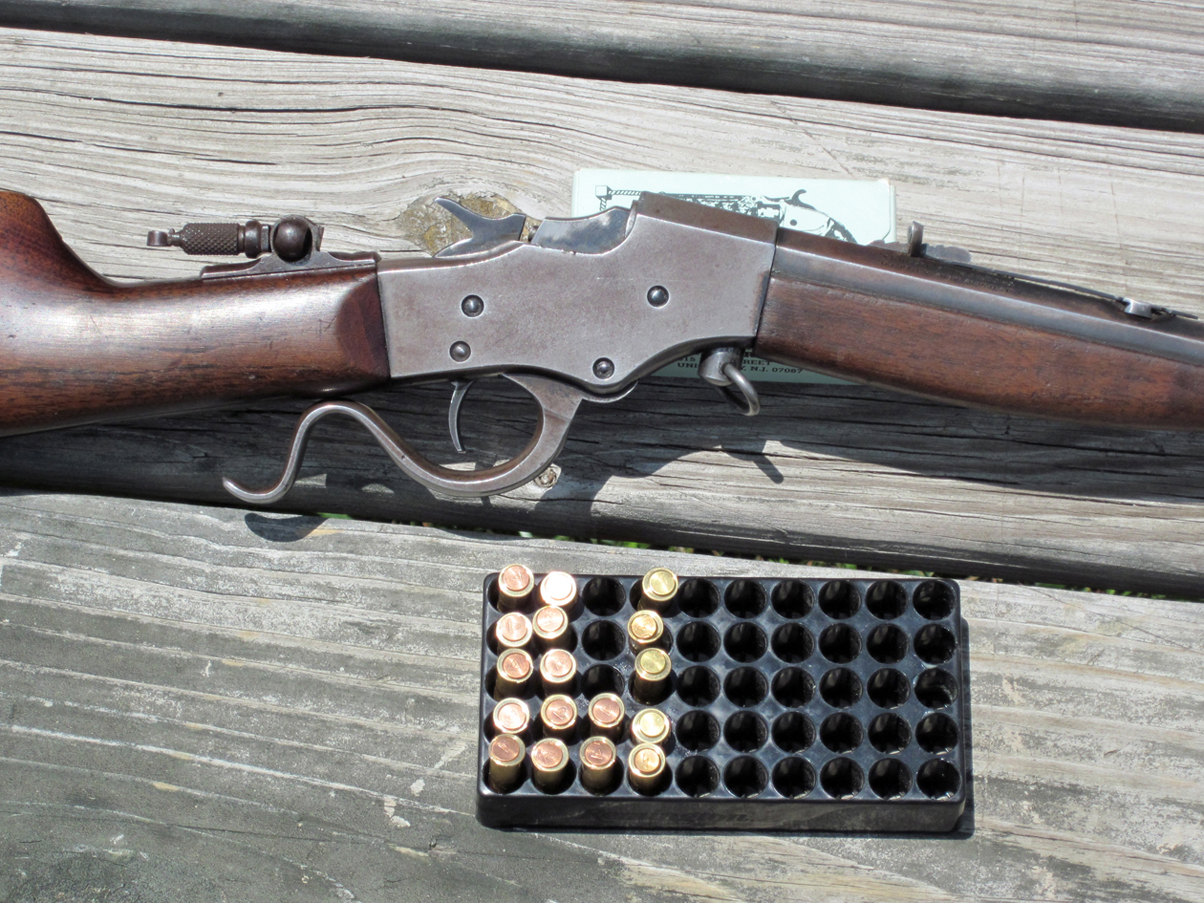
The company can be contacted at the following address. Be sure to tell them the NRVO referred you! |
H&C Company
Boite Postale 28
69563 Saint
Genis-Laval CEDEX
France
Phone:
00-33-9-71-31-05-35
FAX: 00-33-4-72-24-25-32
WEBSITE: www.hc-collection.com
E-MAIL: contact@hc-collection.com
| HUNTING | GUNS | DOGS |
| FISHING & BOATING | TRIP REPORTS | MISCELLANEOUS ESSAYS |
| CONTRIBUTIONS FROM OTHER WRITERS|
| RECIPES |POLITICS |